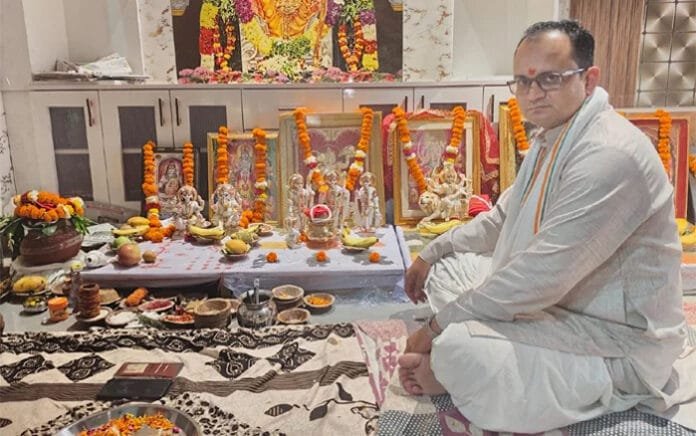Sawan Somwar 2025: Exact Shiv Puja Time, Jalabhishek Ritual & Remedies for Wish Fulfillment
– Article By Pandit Ajay Kaushik –
Sawan Somwar 2025 holds immense spiritual importance for devotees of Lord Shiva. The sacred month of Shravan, which began on 11 July 2025, is believed to be the most auspicious time to worship Bholenath. As per Hindu tradition, the Mondays of Sawan—called Sawan Somwar—carry powerful cosmic energy and divine vibrations. The first Sawan Somwar falls on July 14, and this day is especially revered by devotees across the nation who engage in Jalabhishek, fasting, and Shiva Puja to seek blessings, peace, and fulfillment of desires.
Why Mondays in Sawan Are So Auspicious
Mondays have always been sacred to Mahadev, but when a Monday falls in the month of Sawan, its spiritual potency increases manifold. This is the time when Lord Shiva’s blessings flow freely upon those who worship him with devotion, purity, and ritual discipline. Jalabhishek and fasting on this day are believed to:
Fulfill heartfelt wishes
Remove planetary doshas
Grant success in career, relationships, and health
Strengthen spiritual connection with Shiva
The Divine Story Behind Sawan Somwar Vrat
It is believed that Goddess Parvati performed rigorous penance and observed fasts for 16 consecutive Mondays during the month of Sawan to win Lord Shiva as her husband. Her sincerity moved Lord Shiva, and he accepted her devotion. Since then, the Sawan Somwar Vrat has become a sacred tradition for those seeking marital bliss, life stability, and divine favor.
Auspicious Yogas on 14 July 2025 – First Monday of Sawan
This year’s first Sawan Monday, July 14, is exceptionally auspicious due to the presence of multiple beneficial yogas:
Sankashti Chaturthi Vrat: Removes obstacles and grants relief from sufferings.
Ayushman Yoga: Associated with longevity and vitality.
Saubhagya Yoga: Brings prosperity, happiness, and success.
These rare combinations make this day ideal for performing powerful remedies, starting spiritual sadhanas, and making life-changing vows.
Sawan Somwar 2025 Puja Muhurat and Jalabhishek Timings
Performing puja and Jalabhishek during the following Shubh Muhurats enhances their positive effects:
Brahma Muhurat: 04:15 AM – 05:00 AM
Abhijeet Muhurat: 12:00 PM – 12:50 PM
Pradosh Kaal: 07:15 PM – 08:45 PM
These time slots are considered highly charged with spiritual energy, and devotees are encouraged to perform Shivling Abhishek, recite mantras, and meditate during these periods.
Step-by-Step Shiv Puja Vidhi on Sawan Somwar
To attain maximum blessings from Lord Bholenath on Sawan Monday, follow this complete Puja Vidhi:
Wake up before sunrise and take a holy bath.
Wear clean white, green, or saffron clothes.
Sit in a clean place and meditate on Lord Shiva, Maa Parvati, and Lord Ganesha.
Offer the following items to the Shivling:
Belpatra (three-leaf sacred leaves)
Shami Patra
Gangajal, raw milk, curd, honey, sugar, and ghee
White flowers and sandalwood
Perform Jalabhishek using a copper kalash filled with water and sacred ingredients.
Light a ghee lamp, offer incense and dhoop, and recite:
“Om Namah Shivaya”
“Maha Mrityunjaya Mantra”
Shiv Chalisa
Perform Aarti and conclude the puja with distribution of prasadam.
Maintain a Sawan fast—either nirjala (without water) or phalahar (fruits/milk only).
Powerful Remedies for Special Benefits on Sawan Somwar
1. For Early Marriage:
Chant “Om Shrivar Praday Shree Namah” 108 times using a Rudraksha mala.
Offer saffron-mixed water on the Shivling.
Donate white cloth, sweets, and bangles to a poor Brahmin woman.
2. For Family Peace and Prosperity:
Place a photo or idol of Shiva-Parvati-Ganesh in the northeast direction.
Light five ghee lamps near the Shivling every Monday.
Donate milk, rice, and sugar to Brahmins.
3. For Career Growth and Wealth:
Perform 108 Parikramas (circumambulations) of Shivling while chanting “Om Hreem Namah Shivaya.”
Offer green moong dal and white sandalwood at the temple.
Feed cows or black dogs for improved Saturn and Rahu influence.
Why Women Wear Green in Sawan
In the month of Sawan, women traditionally wear green clothes, bangles, and bindis, especially during Sawan Somwar and Hariyali Teej. The color green symbolizes:
Fertility and harmony
Nature’s abundance
Marital bliss and good fortune
It’s also believed that wearing green pleases Maa Gauri, who bestows happiness and long life for one’s husband.
Spiritual Importance of Jalabhishek in Sawan
Jalabhishek is the ritual act of pouring sacred water and offerings on the Shivling. Each element used has a deeper spiritual meaning:
| Ingredient | Symbolism |
|---|---|
| Gangajal | Purity and liberation from sins |
| Milk | Peace and clarity |
| Honey | Sweetness in relationships |
| Curd | Health and spiritual nourishment |
| Ghee | Divine light and vitality |
| Sugar | Joy and positive energy |
| Belpatra | Devotion, faith, and surrender |
Performing Jalabhishek on each Sawan Somwar, especially in the mentioned muhurats, brings swift blessings and karmic healing.
Solah Somwar Vrat Begins from 14 July
The 16 Somwar Vrat—a potent series of consecutive Monday fasts—begins from July 14 this year. It is highly recommended for:
Unmarried girls seeking a good life partner
Couples praying for harmony and fertility
Individuals wishing for success and liberation
By observing this vrat with dedication and mantra chanting, one gains Akshay Punya (eternal merit) and freedom from misfortune.
Complete Sawan Somwar 2025 Calendar
First Monday – 14 July 2025
Second Monday – 21 July 2025
Third Monday – 28 July 2025
Fourth Monday – 04 August 2025
Each of these Mondays offers a new opportunity to connect with Bholenath, heal your karma, and manifest your life goals through disciplined devotion.
Conclusion:
The first Monday of Sawan on July 14, 2025, is a rare spiritual window filled with divine energy, auspicious yogas, and countless blessings. By following the right rituals, fasts, and remedies, devotees can unlock Shiva’s grace in every aspect of life. Embrace this sacred tradition and immerse yourself in Shravan bhakti to witness transformation and fulfillment.
This article is written by Pandit Ajay Kaushik, a renowned astrologer and authority on Sanatan Dharma and Vedic rituals.














